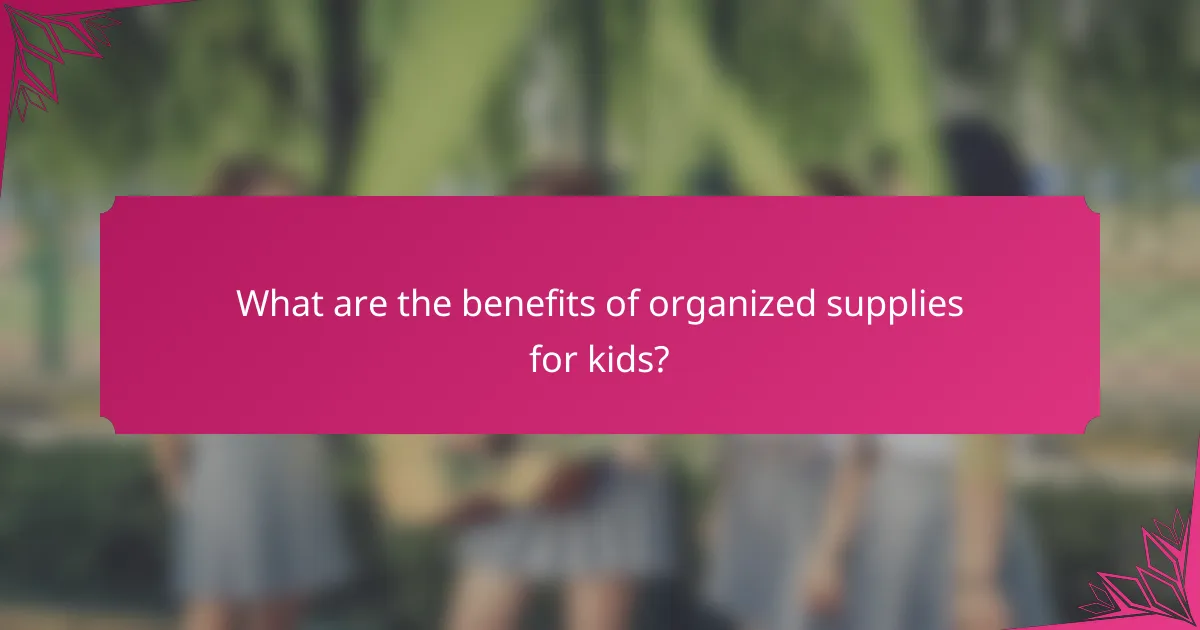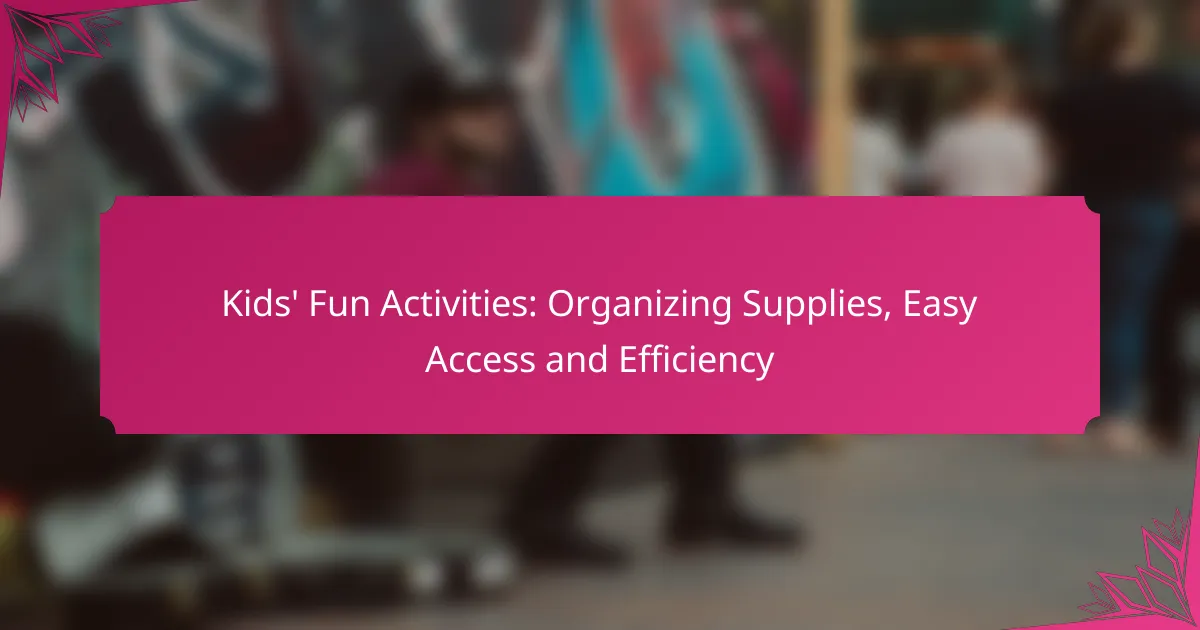Organizing supplies for kids can significantly enhance their playtime, making it both enjoyable and efficient. By implementing smart storage solutions and labeling systems, parents can create a structured environment that fosters creativity and independence. A well-organized craft station, for instance, allows children to access their materials easily, minimizing distractions and maximizing their engagement in activities.

What are the best kids’ fun activities for home organization?
Effective home organization for kids can transform their playtime into a more enjoyable and efficient experience. By utilizing storage solutions, labeling systems, and activity kits, parents can create a structured environment that encourages creativity and independence.
Storage bins for art supplies
Storage bins are essential for keeping art supplies organized and easily accessible. Choose bins that are clear or labeled, allowing kids to quickly identify their contents. Consider using different sizes for various materials, such as larger bins for paper and smaller ones for markers and paints.
Stackable bins can save space and help maintain order. Look for options that are durable and easy for children to handle, promoting a sense of responsibility for their belongings.
Labeling systems for easy access
A labeling system simplifies the process of finding and returning items. Use colorful labels or pictures to help younger children recognize where each item belongs. This not only aids in organization but also teaches kids about categorization.
Consider using a label maker or printable labels for a clean, professional look. Regularly update labels as supplies change to ensure the system remains effective and relevant.
Activity kits for organized play
Activity kits can streamline playtime by providing all necessary materials in one package. These kits can include themed supplies, such as crafting, science experiments, or building sets, which encourage focused play and creativity.
When selecting or creating activity kits, consider the age and interests of your children. Keep kits organized in designated bins or bags to make setup and cleanup quick and easy, fostering a more enjoyable play experience.

How to create an efficient craft station for kids?
Creating an efficient craft station for kids involves organizing supplies for easy access and ensuring a designated area that fosters creativity. This setup helps children engage in activities without unnecessary distractions or frustrations.
Designated workspace for creativity
A designated workspace is essential for encouraging kids to explore their creativity. Choose a specific area in your home, such as a corner of a room or a small table, where they can freely work on their projects without interruptions.
Make sure the workspace is well-lit and has enough room for various activities. Consider using a table that can accommodate multiple children if they want to collaborate on crafts.
Essential tools and materials
Stock the craft station with essential tools and materials that kids will frequently use. Basic supplies should include scissors, glue, markers, colored paper, and various crafting materials like beads or fabric scraps.
Organize these items in clear bins or labeled containers to make it easy for children to find what they need. Regularly check and replenish supplies to keep the station functional and inviting.
Child-friendly furniture options
Select child-friendly furniture that is appropriately sized for kids to ensure comfort and safety. Look for tables and chairs that are low to the ground, allowing easy access for little ones.
Consider investing in adjustable furniture that can grow with your child or multi-functional pieces that can be used for different activities. Soft seating options like bean bags can also provide a cozy spot for kids to relax during breaks.

What are effective ways to manage kids’ toys?
Effective management of kids’ toys involves organizing them in a way that promotes easy access and efficiency. This can be achieved through various strategies that not only declutter spaces but also enhance playtime experiences.
Rotating toy storage systems
Rotating toy storage systems involve keeping a selection of toys accessible while storing the rest away. This method helps maintain interest and reduces clutter, as children are less likely to feel overwhelmed by too many options at once.
Consider using bins or shelves that allow for easy swapping of toys every few weeks. This keeps playtime fresh and exciting, and it can also help teach kids about responsibility and organization.
Space-saving furniture solutions
Space-saving furniture solutions can maximize available areas while providing storage for toys. Look for ottomans, benches, or coffee tables that include hidden compartments for toy storage.
Incorporating multi-functional furniture not only saves space but also keeps toys organized and out of sight when not in use. This can be particularly useful in smaller living areas where every square meter counts.
Interactive play zones
Creating interactive play zones can enhance the organization of toys while encouraging creativity. Designate specific areas in your home for different types of play, such as a reading nook or an arts and crafts corner.
Use clear bins or labels to categorize toys within these zones, making it easy for children to find and return items. This structured approach helps children develop a sense of ownership and responsibility for their belongings.

How can parents encourage kids to organize their supplies?
Parents can encourage kids to organize their supplies by making the process engaging and rewarding. By incorporating fun elements and clear systems, children can learn the importance of tidiness while enjoying the activity.
Incorporating fun organization games
Turning organization into a game can motivate kids to tidy up their supplies. For instance, parents can set a timer and challenge their children to sort their items before time runs out. This adds excitement and urgency to the task.
Another idea is to create a scavenger hunt where kids find and categorize their supplies. This not only makes organizing fun but also helps them learn where everything belongs.
Reward systems for tidy spaces
Implementing a reward system can significantly boost a child’s motivation to keep their supplies organized. Parents can offer small incentives, like stickers or extra playtime, for maintaining a tidy workspace. This reinforces positive behavior and makes organization a desirable habit.
Setting up a points system where kids earn rewards for consistently organized spaces can also be effective. For example, accumulating points could lead to a special outing or a favorite treat, making the effort worthwhile.
Visual organization charts
Visual organization charts can help children understand how to keep their supplies in order. Parents can create colorful charts that outline where each item belongs, using pictures and labels for clarity. This visual aid serves as a constant reminder for kids to follow the system.
Additionally, using clear bins or labeled drawers can complement these charts. When children can see their supplies organized visually, they are more likely to maintain that order independently.

What are the benefits of organized supplies for kids?
Organized supplies significantly enhance a child’s ability to engage in activities effectively. When materials are easily accessible and well-arranged, kids can focus better, unleash their creativity, and develop essential life skills.
Enhanced creativity and focus
When supplies are organized, children can quickly find what they need, which fosters creativity. For example, having art materials sorted by type—like crayons, markers, and paper—allows kids to experiment without interruption. This streamlined access encourages them to dive into projects with enthusiasm and focus.
Additionally, a clutter-free workspace minimizes distractions. A tidy area can help children concentrate on their tasks, leading to more productive and imaginative playtime. Setting up designated spots for different activities can further enhance this effect.
Reduced clutter and stress
Organizing supplies reduces physical clutter, which can lead to a calmer environment. When children can see their materials clearly, they are less likely to feel overwhelmed by chaos. This organization can be as simple as using bins or shelves to categorize items, making it easier for kids to maintain order.
Moreover, a less cluttered space can decrease stress levels for both children and parents. When everything has its place, clean-up becomes quicker and more manageable, allowing for a smoother transition between activities.
Improved responsibility and independence
Teaching kids to organize their supplies instills a sense of responsibility. When children learn to put items back in their designated spots, they develop habits that promote accountability. This practice can be reinforced by involving them in the organization process, allowing them to choose how to arrange their materials.
As kids become more independent in managing their supplies, they gain confidence in their abilities. For instance, allowing them to select their own art supplies for a project encourages decision-making skills and fosters a sense of ownership over their creative endeavors.

How to choose the right storage solutions for kids’ activities?
Selecting the right storage solutions for kids’ activities involves understanding the available space and the specific needs of your children. Effective storage should make supplies easily accessible while keeping the area organized and clutter-free.
Assessing space and needs
Begin by evaluating the space where you plan to store supplies. Measure the area and consider how much storage is feasible without overcrowding. Look for underutilized spaces, such as corners or vertical areas, to maximize storage efficiency.
Next, identify the types of activities your children engage in. For example, if they frequently paint, prioritize storage for art supplies like paints, brushes, and paper. If they enjoy building with blocks, ensure there is ample space for those materials. Tailoring storage to specific activities will enhance accessibility and encourage creativity.
Finally, consider the age and capabilities of your children. Younger kids may need lower storage options that they can reach independently, while older children might benefit from more complex organizational systems. A good rule of thumb is to keep frequently used items within easy reach and less common supplies stored higher or in less accessible areas.
